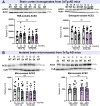This is a preprint.
Higher Angiotensin I Converting Enzyme 2 (ACE2) levels in the brain of individuals with Alzheimer's disease
- PMID: 36711734
- PMCID: PMC9882134
- DOI: 10.1101/2023.01.17.524254
Higher Angiotensin I Converting Enzyme 2 (ACE2) levels in the brain of individuals with Alzheimer's disease
Update in
-
Higher angiotensin-converting enzyme 2 (ACE2) levels in the brain of individuals with Alzheimer's disease.Acta Neuropathol Commun. 2023 Oct 2;11(1):159. doi: 10.1186/s40478-023-01647-1. Acta Neuropathol Commun. 2023. PMID: 37784209 Free PMC article.
Abstract
The severe acute respiratory syndrome coronavirus 2 (SARS-CoV-2) is a major cause of death in the elderly. Cognitive decline due to Alzheimer's disease (AD) is frequent in the geriatric population disproportionately affected by the COVID-19 pandemic. Interestingly, central nervous system (CNS) manifestations have been reported in SARS-CoV-2-infected patients. In this study, we investigated the levels of Angiotensin I Converting Enzyme 2 (ACE2), the main entry receptor of SARS-COV-2 in cells, in postmortem parietal cortex samples from two independent AD cohorts, totalling 142 persons. Higher concentrations of ACE2 protein and mRNA were found in individuals with a neuropathological diagnosis of AD compared to age-matched healthy control subjects. Brain levels of soluble ACE2 were inversely associated with cognitive scores (p = 0.02), markers of pericytes (PDGFRβ, p=0.02 and ANPEP, p = 0.007) and caveolin1 (p = 0.03), but positively correlated with soluble amyloid-β peptides (Aβ) concentrations (p = 0.01) and insoluble phospho- tau (S396/404, p = 0.002). No significant differences in ACE2 were observed in the 3xTgAD mouse model of tau and Aβ neuropathology. Results from immunofluorescence and Western blots showed that ACE2 protein is mainly localized in neurons in the human brain but predominantly in microvessels in the mouse brain. The present data show that an AD diagnosis is associated with higher levels of soluble ACE2 in the human brain, which might contribute to a higher risk of CNS SARS-CoV-2 infection.
Conflict of interest statement
Competing interests
The authors report no competing interests.
Figures






References
Publication types
Grants and funding
LinkOut - more resources
Full Text Sources
Miscellaneous
